Pyridoxal and Salicylaldehyde Derivatives: Synthesis, Characterization, and Antifungal Potential Against Opportunistic Yeast Pathogens
Abstract
1. Introduction
2. Results and Discussion
2.1. Chemistry
2.1.1. Synthesis of Pyridoxal Derivatives 2–5
2.1.2. Synthesis of Dihydrobenzoxepines 6a and 6b
2.1.3. Synthesis of Triazoles 7
2.1.4. Synthesis of Triazoles 9
2.1.5. Synthesis of Salicylaldehyde Derivatives 11–21
2.2. In Vitro Antifungal Activity Against Strains of C. albicans, C. neoformans, and C. auris
2.3. Structure–Activity Relationships (SAR) Analysis
2.4. Cytotoxic Activity
2.5. ADMET Profile for Compounds 6a, 6b, 12b, and 19b
3. Materials and Methods
3.1. General Information
3.2. Synthetic Procedures
3.2.1. General Procedure for the Synthesis of Compounds 2a and 2b
3.2.2. General Procedure for the Synthesis of Compounds 3a–d
3.2.3. General Procedure for the Synthesis of Compounds 4a–d
3.2.4. General Procedure for the Synthesis of Compounds 5a–c
3.2.5. General Procedure for the Synthesis of Compounds 6a and 6b
3.2.6. General Procedure for the Synthesis of Compounds 7a–g
3.2.7. General Procedure for the Synthesis of Compound 8a
3.2.8. General Procedure for the Synthesis of Compounds 9a and 9b
3.2.9. General Procedure for the Synthesis of Compounds 11a and 11b
3.2.10. General Procedure for the Synthesis of Compounds 12a and 12b
3.2.11. General Procedure for the Synthesis of Compounds 15a, 15b, 16a, 19a, and 19b
3.2.12. General Procedure for the Synthesis of Compound 20
3.2.13. General Procedure for the Synthesis of Compounds 21a and 21b
3.3. Antifungal Activity
3.3.1. Fungal Strains
3.3.2. Antifungal Activity Assays
3.4. Viability Test by Means of MTT (3-(4,5-dimethylthiazol-2-yl)-2,5-diphenyltetrazolium Bromide)
3.5. In Silico ADMET Analysis
4. Conclusions
Supplementary Materials
Author Contributions
Funding
Institutional Review Board Statement
Informed Consent Statement
Data Availability Statement
Acknowledgments
Conflicts of Interest
References
- Kainz, K.; Bauer, M.A.; Madeo, F.; Carmona-Gutierrez, D. Fungal infections in humans: The silent crisis. Microb. Cell 2020, 7, 143–145. [Google Scholar] [CrossRef]
- Firacative, C. Invasive fungal disease in humans: Are we aware of the real impact? Mem. Inst. Oswaldo Cruz 2020, 115, e200430. [Google Scholar] [CrossRef] [PubMed]
- Gow, N.A.R.; Van De Veerdonk, F.L.; Brown, A.J.P.; Netea, M.G. Candida albicans morphogenesis and host defence: Discriminating invasion from colonization. Nat. Rev. Microbiol. 2012, 10, 112–122. [Google Scholar] [CrossRef] [PubMed]
- Parra-Giraldo, C.M.; Valderrama, S.L.; Cortes-Fraile, G.; Garzón, J.R.; Ariza, B.E.; Morio, F.; Linares-Linares, M.Y.; Ceballos-Garzón, A.; de la Hoz, A.; Hernandez, C.; et al. First report of sporadic cases of Candida auris in Colombia. Int. J. Infect. Dis. 2018, 69, 63–67. [Google Scholar] [CrossRef] [PubMed]
- de Oliveira, H.C.; Trevijano-Contador, N.; Garcia-Rodas, R. Cryptococcal Pathogenicity and Morphogenesis. Curr. Fungal Infect. Rep. 2019, 13, 67–76. [Google Scholar] [CrossRef]
- Soriano, A.; Honore, P.M.; Puerta-Alcalde, P.; Garcia-Vidal, C.; Pagotto, A.; Gonçalves-Bradley, D.C.; Verweij, P.E. Invasive candidiasis: Current clinical challenges and unmet needs in adult populations. J. Antimicrob. Chemother. 2023, 78, 1569–1585. [Google Scholar] [CrossRef] [PubMed]
- Szymański, M.; Chmielewska, S.; Czyżewska, U.; Malinowska, M.; Tylicki, A. Echinocandins–structure, mechanism of action and use in antifungal therapy. J. Enzym. Inhib. Med. Chem. 2022, 37, 876–894. [Google Scholar] [CrossRef]
- Shafiei, M.; Peyton, L.; Hashemzadeh, M.; Foroumadi, A. History of the development of antifungal azoles: A review on structures, SAR, and mechanism of action. Bioorg. Chem. 2020, 104, 104240. [Google Scholar] [CrossRef] [PubMed]
- Costa-de-oliveira, S.; Rodrigues, A.G. Candida albicans antifungal resistance and tolerance in bloodstream infections: The triad yeast-host-antifungal. Microorganisms 2020, 8, 154. [Google Scholar] [CrossRef] [PubMed]
- López-Ávila, K.; Dzul-Rosado, K.R.; Lugo-Caballero, C.; Arias-León, J.J.; Zavala-Castro, J.E. Mecanismos de resistencia antifúngica de los azoles en Candida albicans. Una revisión. Rev. Bioméd. 2016, 27, 145–159. [Google Scholar] [CrossRef][Green Version]
- Zhao, Y.; Ye, L.; Zhao, F.; Zhang, L.; Lu, Z.; Chu, T.; Wang, S.; Liu, Z.; Sun, Y.; Chen, M.; et al. Cryptococcus neoformans, a global threat to human health. Infect. Dis. Poverty 2023, 12, 20. [Google Scholar] [CrossRef] [PubMed]
- Spadari, C.D.C.; Wirth, F.; Lopes, L.B.; Ishida, K. New approaches for cryptococcosis treatment. Microorganisms 2020, 8, 613. [Google Scholar] [CrossRef] [PubMed]
- Wu, W.N.; Jiang, Y.M.; Fei, Q.; Du, H.T.; Yang, M.F. Synthesis and antifungal activity of novel 1,2,4-triazole derivatives containing an amide moiety. J. Heterocycl. Chem. 2020, 57, 1379–1386. [Google Scholar] [CrossRef]
- Jiang, W.; Cheng, W.; Zhang, T.; Lu, T.; Wang, J.; Yan, Y.; Tang, X.; Wang, X. Synthesis and antifungal activity evaluation of novel pyridine derivatives as potential succinate dehydrogenase inhibitors. J. Mol. Struct. 2022, 1270, 133901. [Google Scholar] [CrossRef]
- Wang, S.Q.; Wang, Y.F.; Xu, Z. Tetrazole hybrids and their antifungal activities. Eur. J. Med. Chem. 2019, 170, 225–234. [Google Scholar] [CrossRef] [PubMed]
- Diaz-Velandia, J.; Durán-Díaz, N.; Robles-Camargo, J.; Loaiza, A.E. Synthesis and in vitro assessment of antifungal activity of oximes, oxime ethers and isoxazoles. Univ. Sci. 2011, 16, 294–302. [Google Scholar] [CrossRef]
- Prabhakar, V.; Babu, K.S.; Ravindranath, L.K.; Latha, J. Design, Synthesis, Characterization and Biological Activity of Novel Thieno[2,3-d]pyrimidine Derivatives. Indian J. Adv. Chem. Sci. 2017, 5, 30–42. [Google Scholar]
- Yamazaki, H.; Rotinsulu, H.; Kaneko, T.; Murakami, K.; Fujiwara, H.; Ukai, K.; Namikoshi, M. A new dibenz[b,e]oxepine derivative, 1-hydroxy-10-methoxy-dibenz[b,e] oxepin-6,11-dione, from a marine-derived fungus, Beauveria bassiana TPU942. Mar. Drugs 2012, 10, 2691–2697. [Google Scholar] [CrossRef]
- Cardoso, J.; Nakayama, D.G.; Sousa, E.; Pinto, E. Marine-Derived Compounds and Prospects for Their Antifungal Application. Molecules 2020, 25, 5856. [Google Scholar] [CrossRef] [PubMed]
- Kahnberg, P.; Sterner, O. Synthesis of the antifungal 1-benzoxepin pterulone. Tetrahedron 2001, 57, 7181–7184. [Google Scholar] [CrossRef]
- Malefo, M.S.; Ramadwa, T.E.; Famuyide, I.M.; McGaw, L.J.; Eloff, J.N.; Sonopo, M.S.; Selepe, M.A. Synthesis and Antifungal Activity of Chromones and Benzoxepines from the Leaves of Ptaeroxylon obliquum. J. Nat. Prod. 2020, 83, 2508–2517. [Google Scholar] [CrossRef]
- Vlad, I.M.; Nuta, D.C.; Chirita, C.; Caproiu, M.T.; Draghici, C.; Dumitrascu, F.; Bleotu, C.; Avram, S.; Udrea, A.M.; Missir, A.V.; et al. In Silico and In Vitro Experimental Studies of New Dibenz[b,e]oxepin-11(6H)one O-(arylcarbamoyl)-oximes Designed as Potential Antimicrobial Agents. Molecules 2020, 25, 321. [Google Scholar] [CrossRef]
- Kurokawa, M.; Sato, F.; Masuda, Y.; Yoshida, T.; Ochi, Y.; Zushi, K.; Fujiwara, I.; Naruto, S.; Uno, H.; Matsumoto, J. Synthesis and Biological Activity of 11-(4-(Cinnamyl)-1-piperazinyl)-6, 11-dihydrodibenzo(b,e)oxepin Derivatives, Potential Agents for the Treatment of Cerebrovascular Disorders. Chem. Pharm. Bull. 1992, 39, 2564–2573. [Google Scholar] [CrossRef][Green Version]
- Scoccia, J.; Castro, M.J.; Faraoni, M.B.; Bouzat, C.; Martín, V.S.; Gerbino, D.C. Efficient synthesis and biological evaluation of dibenzo[b,e]oxepin-11(6H)-ones as potential anthelmintic agents. In Proceedings of the 20th International Electronic Conference on Synthetic Organic Chemistry, Bahía Blanca, Argentina, 1–30 November 2016; pp. 1–12. [Google Scholar] [CrossRef][Green Version]
- Gašparová, R. Natural Compounds with Oxepinochromene Scaffold. Structure, Source, Biological Activity and Synthesis. Chem. Biodivers. 2022, 19, e202200507. [Google Scholar] [CrossRef]
- Pericherla, K.; Khedar, P.; Khungar, B.; Kumar, A. Click chemistry inspired structural modification of azole antifungal agents to synthesize novel ‘drug like’ molecules. Tetrahedron Lett. 2012, 53, 6761–6764. [Google Scholar] [CrossRef]
- Marzi, M.; Farjam, M.; Kazeminejad, Z.; Shiroudi, A.; Kouhpayeh, A.; Zarenezhad, E. A Recent Overview of 1,2,3-Triazole-Containing Hybrids as Novel Antifungal Agents: Focusing on Synthesis, Mechanism of Action, and Structure-Activity Relationship (SAR). J. Chem. 2022, 2022, 7884316. [Google Scholar] [CrossRef]
- McNulty, J.; Das, P.; McLeod, D. Microwave-assisted, aqueous wittig reactions: Organic-solvent- And protecting-group-free chemoselective synthesis of functionalized alkenes. Chemistry 2010, 16, 6756–6760. [Google Scholar] [CrossRef]
- Bejarano, C.A.; Díaz, J.E.; Camacho, J.; Flores-Bernal, G.G.; Miranda, L.D.; Mejía, S.M.; Loaiza, A.E. Study of the Mechanism of 7-exo-trig Cyclizations of Aryl, Vinyl, and Alkyl Radicals on Oxime Ethers. Eur. J. Org. Chem. 2024, 27, e202301148. [Google Scholar] [CrossRef]
- Bejarano, C.A.; Díaz, J.E.; Cifuentes-López, A.; López, L.V.; Jaramillo-Gómez, L.M.; Buendia-Atencio, C.; Velásquez, V.P.L.; Mejía, S.M.; Loaiza, A.E. Experimental and theoretical study of the mechanism and rate constants of the sequential 5-exo-trig spirocyclization involving vinyl, aryl and N-alkoxyaminyl radicals. Org. Biomol. Chem. 2022, 20, 4141–4154. [Google Scholar] [CrossRef]
- Himo, F.; Lovell, T.; Hilgraf, R.; Rostovtsev, V.V.; Noodleman, L.; Sharpless, K.B.; Fokin, V.V. Copper(I)-catalyzed synthesis of azoles. DFT study predicts unprecedented reactivity and intermediates. J. Am. Chem. Soc. 2005, 127, 210–216. [Google Scholar] [CrossRef] [PubMed]
- Baul, T.S.B. Antimicrobial activity of organotin(IV) compounds: A review. Appl. Organomet. Chem. 2008, 22, 195–204. [Google Scholar] [CrossRef]
- Süloǧlu, A.K.; Karacaoǧlu, E.; Koçkaya, E.A.; Selmanoǧlu, G.; Loǧoglu, E. Cytotoxic effects of a novel thialo benzene derivative 2,4-Dithiophenoxy-1- iodo-4-bromobenzene (C18H12S2IBr) in L929 cells. Int. J. Toxicol. 2014, 33, 319–324. [Google Scholar] [CrossRef]
- Lipinski, C.A.; Dominy, B.W.; Feeney, P.J. Experimental and computational approaches to estimate solubility and permeability in drug discovery and development settings. Adv. Drug Deliv. Rev. 1997, 23, 3–25. [Google Scholar] [CrossRef]
- Vargas-Casanova, Y.; Poveda, J.C.V.; Rivera-Monroy, Z.J.; Garzón, A.C.; Fierro-Medina, R.; Le Pape, P.; García-Castañeda, J.E.; Giraldo, C.M.P. Palindromic Peptide LfcinB (21-25)Pal Exhibited Antifungal Activity against Multidrug-Resistant Candida. ChemistrySelect 2020, 5, 7236–7242. [Google Scholar] [CrossRef]
- Casanova, Y.V.; Guerra, J.A.R.; Pérez, Y.A.U.; Castro, A.L.L.; Reina, G.A.; Castañeda, J.E.G.; Monroy, Z.J.R. Antibacterial Synthetic Peptides Derived from Bovine Lactoferricin Exhibit Cytotoxic Effect against MDA-MB-468 and MDA-MB-231 Breast Cancer Cell Lines. Molecules 2017, 22, 1641. [Google Scholar] [CrossRef] [PubMed]
- Booth, S.E.; Jenkins, P.R.; Swainb, C.J.; Sweeney, J. Intramolecular Addition of Vinyl and Aryl Radicals to Oxime Ethers in the Synthesis of Five-, Six-and Seven-membered Ring Systems. J. Chem. Soc. Perkin Trans. 1994, 23, 3499–3508. [Google Scholar] [CrossRef]
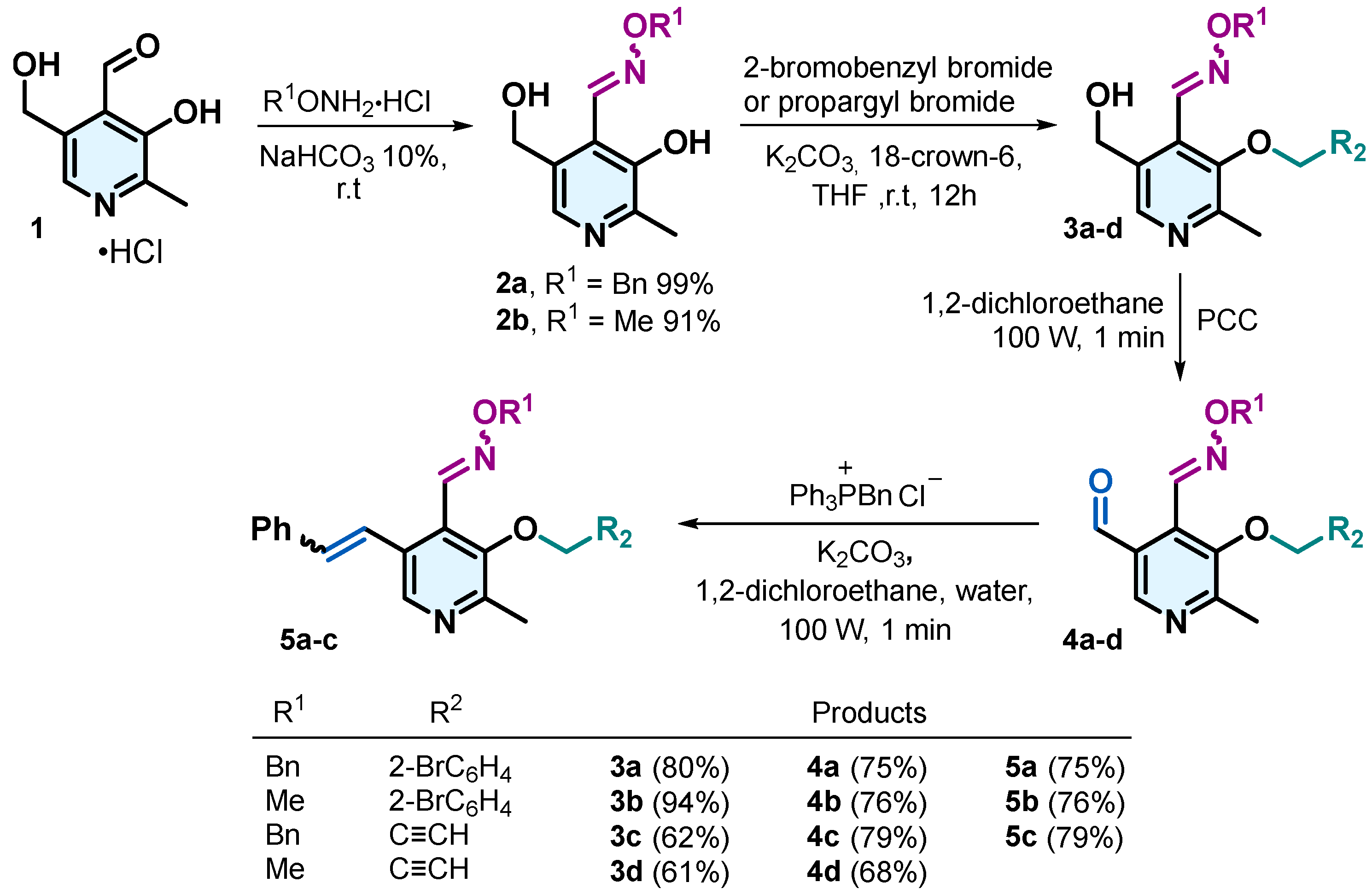

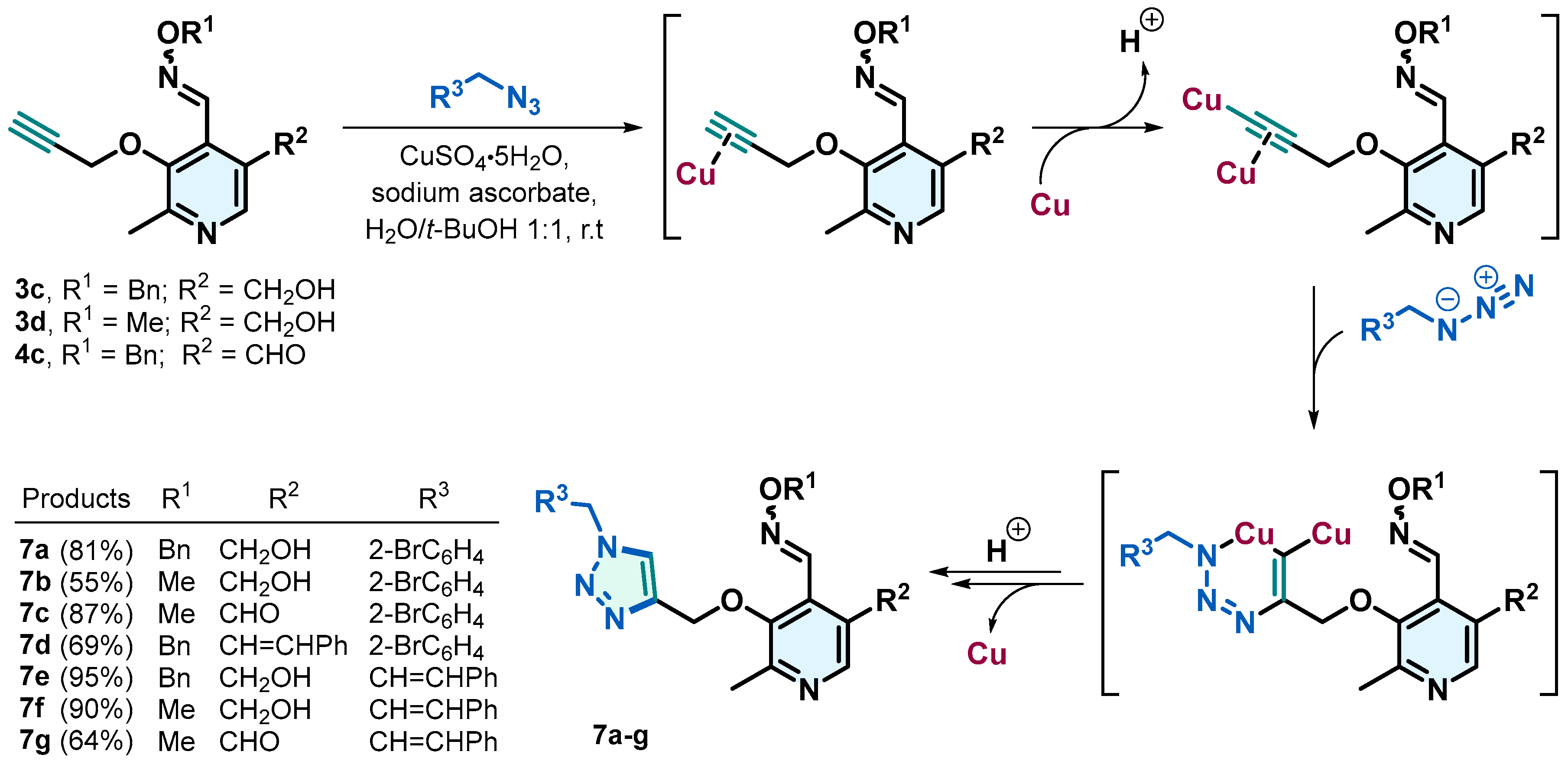

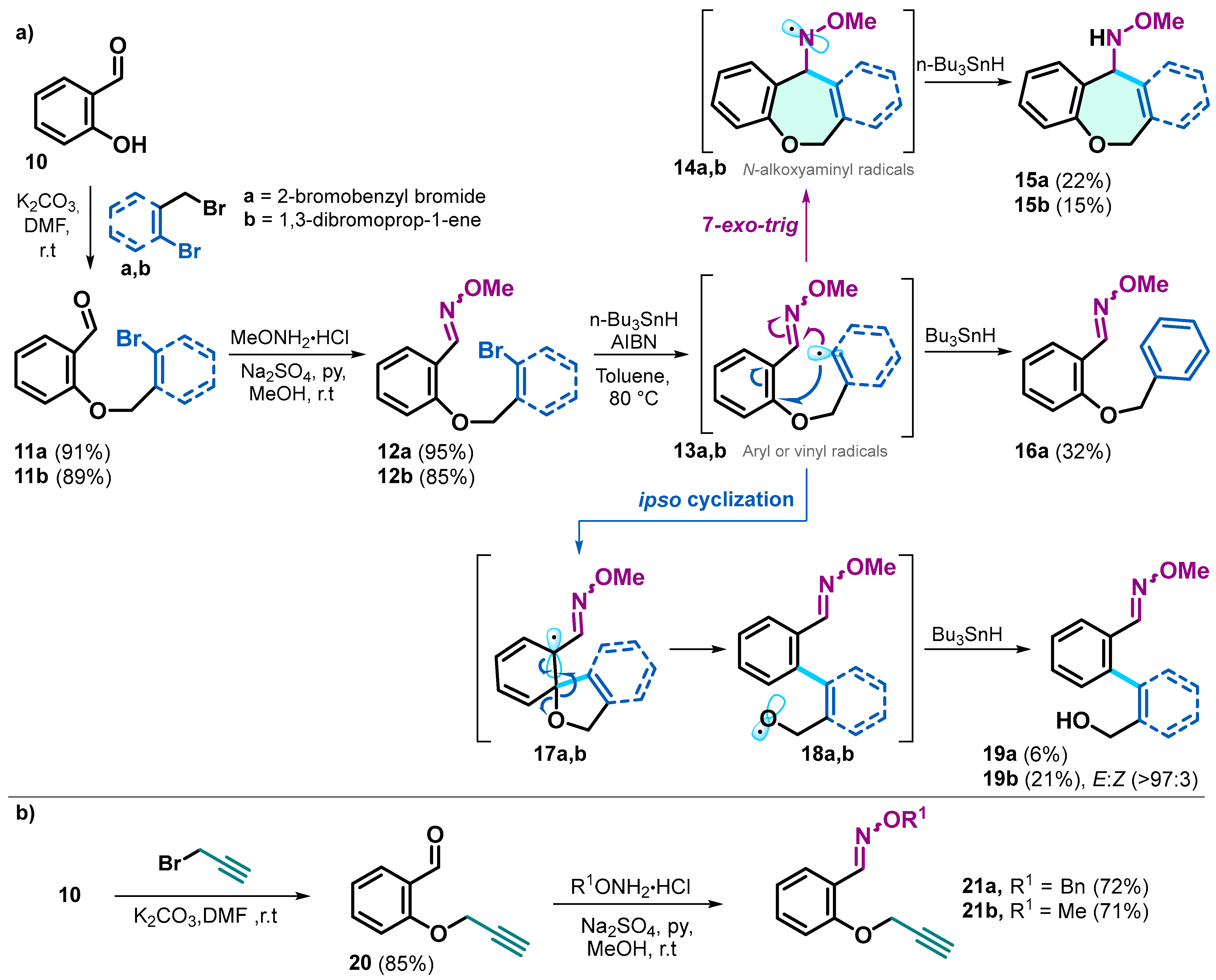
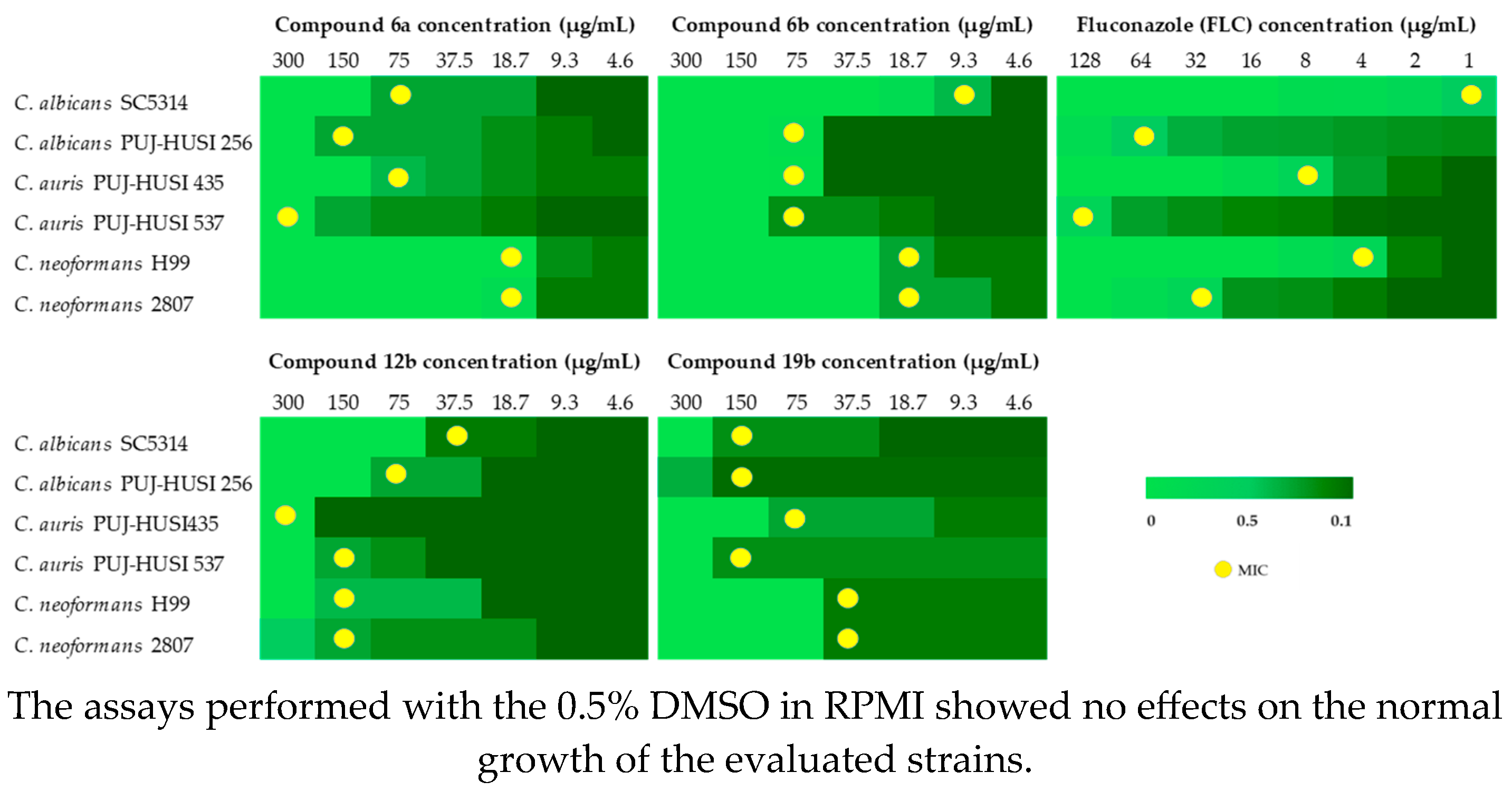
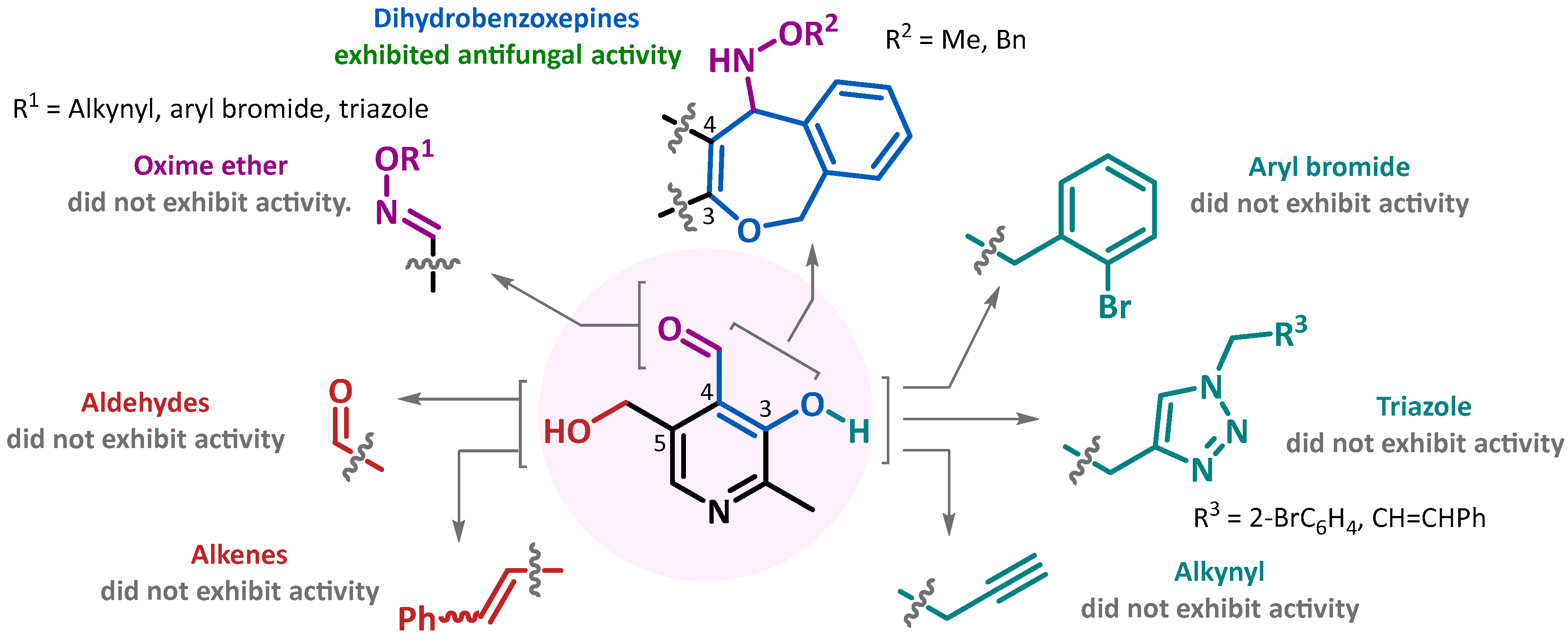
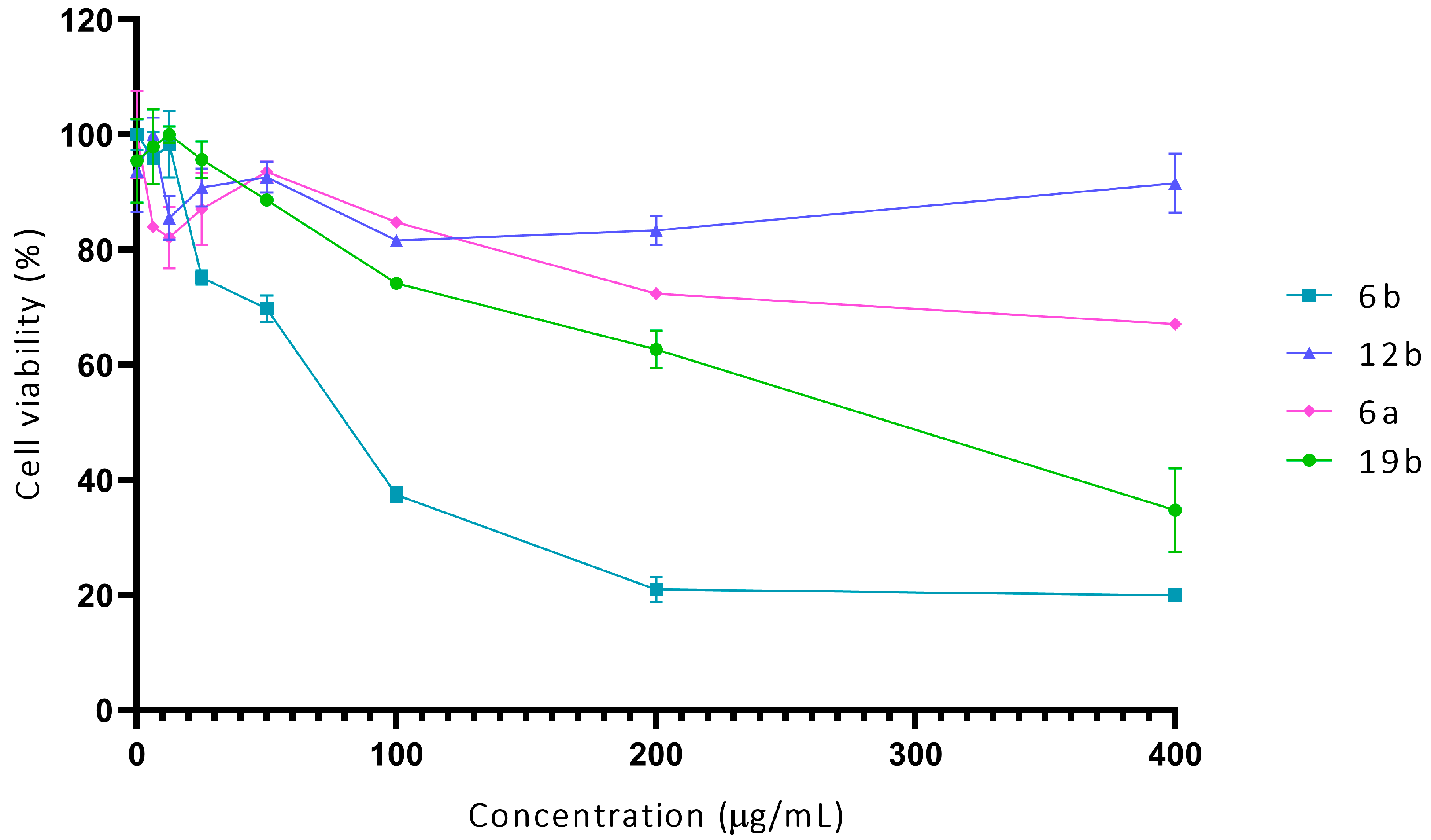
Disclaimer/Publisher’s Note: The statements, opinions and data contained in all publications are solely those of the individual author(s) and contributor(s) and not of MDPI and/or the editor(s). MDPI and/or the editor(s) disclaim responsibility for any injury to people or property resulting from any ideas, methods, instructions or products referred to in the content. |
© 2025 by the authors. Licensee MDPI, Basel, Switzerland. This article is an open access article distributed under the terms and conditions of the Creative Commons Attribution (CC BY) license (https://creativecommons.org/licenses/by/4.0/).
Share and Cite
Camacho, J.; Bejarano, C.A.; Diaz, J.E.; Vargas-Casanova, Y.; Carvajal, S.K.; Diaz Santoyo, V.; Parra-Giraldo, C.M.; Loaiza, A.E. Pyridoxal and Salicylaldehyde Derivatives: Synthesis, Characterization, and Antifungal Potential Against Opportunistic Yeast Pathogens. Molecules 2025, 30, 1165. https://doi.org/10.3390/molecules30051165
Camacho J, Bejarano CA, Diaz JE, Vargas-Casanova Y, Carvajal SK, Diaz Santoyo V, Parra-Giraldo CM, Loaiza AE. Pyridoxal and Salicylaldehyde Derivatives: Synthesis, Characterization, and Antifungal Potential Against Opportunistic Yeast Pathogens. Molecules. 2025; 30(5):1165. https://doi.org/10.3390/molecules30051165
Chicago/Turabian StyleCamacho, Jairo, Carlos A. Bejarano, John E. Diaz, Yerly Vargas-Casanova, Silvia Katherine Carvajal, Valentina Diaz Santoyo, Claudia M. Parra-Giraldo, and Alix E. Loaiza. 2025. "Pyridoxal and Salicylaldehyde Derivatives: Synthesis, Characterization, and Antifungal Potential Against Opportunistic Yeast Pathogens" Molecules 30, no. 5: 1165. https://doi.org/10.3390/molecules30051165
APA StyleCamacho, J., Bejarano, C. A., Diaz, J. E., Vargas-Casanova, Y., Carvajal, S. K., Diaz Santoyo, V., Parra-Giraldo, C. M., & Loaiza, A. E. (2025). Pyridoxal and Salicylaldehyde Derivatives: Synthesis, Characterization, and Antifungal Potential Against Opportunistic Yeast Pathogens. Molecules, 30(5), 1165. https://doi.org/10.3390/molecules30051165






